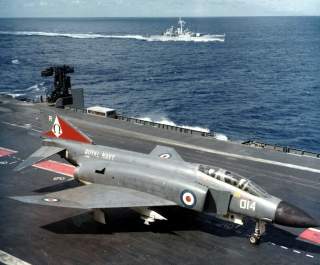Rare Footage Found of Royal Navy Phantoms Practicing Aboard the Aircraft Carrier HMS Eagle
You have to watch this.
As it can be seen in the footage the FAA variant of the venerable F-4 required a telescopic nose wheel oleo to increase the angle of attack on take off from the small decks of British flattops.
Filmed aboard the HMS Eagle (R05) in 1969, the following spectacular vintage video shows McDonnell Douglas Phantom FG.Mk 1s undertaking trials before entering the operational service with the Fleet Air Arm (FAA).
Already equipped with subsonic De Havilland Sea Vixen all weather fighters and Blackburn Buccaneer low level strike aircraft, the Eagle was chosen to test the then new supersonic Phantom which was selected by the Royal Navy in 1964 to meet the requirement for a new generation of fighter aircraft to serve aboard its carriers. As it can be seen in the footage the FAA variant of the venerable F-4 required a telescopic nose wheel oleo to increase the angle of attack on take off from the small decks of British flattops.
Phantoms conducted extensive trials aboard from Mar. to Jun. 1969 but the HMS Ark Royal (R09), not the Eagle, was eventually chosen to operate the Phantoms of 892 Squadron, the only operational FAA unit to fly the Phantom FG.Mk 1.
Noteworhty both carriers underwent a series of modifications to accomodate the new jets such as an 8° angled deck, new and more powerful steam catapults and heavy weight arrestor gear. Actually why the Ark Royal had been chosen over the Eagle has never been revealed. In fact the latter was not only a more reliable ship featuring a hull in better condition than that of the Ark Royal but also a more modern aircraft carrier fitted with more advanced sensors which were integrated in it during the 1964 refit.
This article by Dario Leone originally appeared on The Aviation Geek Club in 2016.
Image: Wikimedia.

